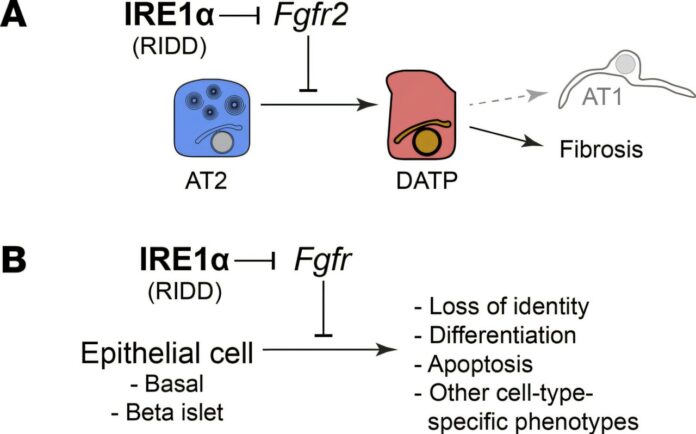A major breakthrough in our understanding of pain has been revealed in a collaborative study led by a Leeds scientist, opening the door to new ways of tackling long term pain without harmful and addictive opioids.
Professor Nikita Gamper from the University of Leeds’s School of Biomedical Sciences and his team has discovered the body can effectively produce its own targeted “sleeping pills”—akin to benzodiazepines—dulling signals from a particular nerve and controlling how much pain a person feels.
The findings, which build on previous work by Professor Gamper and Professor Xiaona Du at Hebei Medical University in Shijiazhuang, China, could pave the way for a significant breakthrough in treating pain, moving away from strong opioids like morphine or fentanyl.
Professor Gamper said, “We understand quite a bit about how a person ends up feeling pain, but we can’t do much about it. Despite all the amazing discoveries and textbooks written, opioids are still the gold standard.
“Nothing substantially better than opioids has been produced. If you suffer from pain, you will likely end up with either ibuprofen, which is OK for mild pain, but absolutely does nothing for very strong pain or neuropathic pain; or opioids which are very efficacious but dangerous.”
Benzodiazepines (“benzos”) are a class of depressant drugs that are used as sleeping pills and to treat anxiety and seizures. Professor Gamper and his colleagues Professor Du and Dr. Temugin Berta at the University of Cincinnati found that some cells attached to human nerves, residing in structures called spinal ganglia, can release a peptide that works on the same principle as benzos. But because the process is localized to the peripheral nervous system, these peptides do not cause the whole nervous system to “go to sleep”—meaning they don’t carry the same risks as harmful and addictive opioids.
The findings effectively reveal that nerves can “tune out” pain signals or restrict the amount of pain the brain thinks a person is experiencing.
Dr. Ganesan Baranidharan, a consultant in pain medicine in Leeds, said the findings could offer some hope to patients trying to manage daily chronic pain.
He said, “Chronic pain is one of the health service’s biggest problems. In clinics we try to manage pain with ‘self management’—learning to live with pain—or we try to help where we can with physiotherapy, injections or surgeries. However, some patients will have persistent pain needing medicines, and long-term use of nerve painkillers and opioids can cause significant side effects such as feeling like a zombie, memory impairment etc.
“While some patients do really well on small dose opioids, we need more options to treat chronic pain. The more we can discover, and find appropriate drugs to treat certain conditions, the better for our patients.”
Professor Nikita’s findings—published in the Journal of Clinical Investigation in June 2024—open up the possibility of developing new, targeted medicines that could block pain signals without crossing the blood-brain barrier and affecting other brain functions.
For up to a third of the world’s population, pain is a daily burden, and despite being the primary reason for doctor visits across the world pain is still poorly treated.
Cincinnati’s Dr. Berta added, “Millions of people suffer from chronic pain and more than half have trouble finding adequate relief. As pain scientists, we have the opportunity to discover new mechanisms that contribute to the progression of chronic pain and share breakthroughs that may hold promise for new treatment strategies.”
Professor Gamper’s decision to focus his work in this area was strongly influenced by seeing a member of his immediate family suffer with neuropathic pain.
He added, “Pain is an interesting phenomenon to study, but ultimately it’s not curiosity that drives you, it’s the ability or at least opportunity to relieve people from pain.”
The teams in Leeds and Shijiazhuang worked together from the research’s inception, with Dr. Berta in Cincinnati coming on board after the scientists discussed their work at a Society for Neuroscience conference in 2018.
Although the scientists had not previously met, they knew each other’s work and by sharing knowledge they soon realized they had been working on similar experiments and produced identical results. Dr. Berta believes their work “embodies the collaborative spirit of academic research” and shows how significant advancements in understanding and treating pain can be made when scientists work together.
Professor Du said, “I vividly recall the excitement when Nikita informed me that Temo’s lab had obtained similar primary results to ours, solidifying our decision to pursue the study further. I hope that our future collaboration will yield even more and better outcomes.”
More information:
Xinmeng Li et al, Peripheral gating of mechanosensation by glial diazepam binding inhibitor, Journal of Clinical Investigation (2024). DOI: 10.1172/JCI176227
University of Leeds
Citation:
Chronic pain, opioids and natural benzos: Researchers discover how body can make its own ‘sleeping pills’ (2024, December 17)
retrieved 17 December 2024
from https://medicalxpress.com/news/2024-12-chronic-pain-opioids-natural-benzos.html
This document is subject to copyright. Apart from any fair dealing for the purpose of private study or research, no
part may be reproduced without the written permission. The content is provided for information purposes only.


